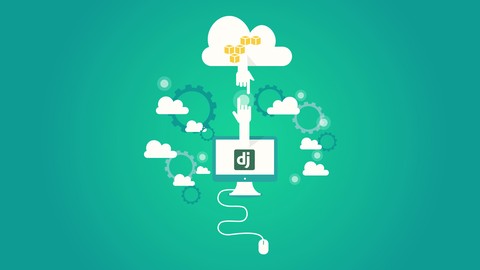
Django in AWS (EC2): Fundamentals Course
Django in AWS (EC2): Fundamentals Course, available at $44.99, has an average rating of 4.55, with 46 lectures, based on 251 reviews, and has 3681 subscribers.
You will learn about Go from a simple EC2 server on the Free Tier to a load balanced, server cluster that scales automatically depending on the current traffic levels Understand the different instance types, how much they cost, and how to stay within the Free Tier Launch an Amazon EC2 server preconfigured with Django Launch a regular Ubuntu 14.04 server and configure it for Django Update your Security Group settings with the appropriate amount of access Connect to your instance via both the command line (SSH) and your browser (Java-SSH) Setup your your project files on EC2 using FTP Serve your project files on EC2 (Django will not do this for you in production) Leverage S3 Cloud Storage & CloudFront CDN to speed up your site Utilize Amazon's Premium DNS service Route 53 to register and manage your Domain Name Ways to enhance security on AWS – including Multi-factor authentication, IAM Users, Groups, Policies, and more Create backup machine images of your project in case of failover and to scale out easily How to upgrade your servers hardware for an instant performance boost Separate your web server from your database server with automatic backups and replication using Amazon RDS Load balance your traffic between several additional EC2 instances Automatically scale up and down your server cluster depending on the current traffic levels This course is ideal for individuals who are (Django) Web Developers It is particularly useful for (Django) Web Developers.
Enroll now: Django in AWS (EC2): Fundamentals Course
Summary
Title: Django in AWS (EC2): Fundamentals Course
Price: $44.99
Average Rating: 4.55
Number of Lectures: 46
Number of Published Lectures: 46
Number of Curriculum Items: 46
Number of Published Curriculum Objects: 46
Original Price: $22.99
Quality Status: approved
Status: Live
What You Will Learn
- Go from a simple EC2 server on the Free Tier to a load balanced, server cluster that scales automatically depending on the current traffic levels
- Understand the different instance types, how much they cost, and how to stay within the Free Tier
- Launch an Amazon EC2 server preconfigured with Django
- Launch a regular Ubuntu 14.04 server and configure it for Django
- Update your Security Group settings with the appropriate amount of access
- Connect to your instance via both the command line (SSH) and your browser (Java-SSH)
- Setup your your project files on EC2 using FTP
- Serve your project files on EC2 (Django will not do this for you in production)
- Leverage S3 Cloud Storage & CloudFront CDN to speed up your site
- Utilize Amazon's Premium DNS service Route 53 to register and manage your Domain Name
- Ways to enhance security on AWS – including Multi-factor authentication, IAM Users, Groups, Policies, and more
- Create backup machine images of your project in case of failover and to scale out easily
- How to upgrade your servers hardware for an instant performance boost
- Separate your web server from your database server with automatic backups and replication using Amazon RDS
- Load balance your traffic between several additional EC2 instances
- Automatically scale up and down your server cluster depending on the current traffic levels
Who Should Attend
- (Django) Web Developers
Target Audiences
- (Django) Web Developers
Setting up servers for your business or startup can be a tedious and expensive process, particularly when you’re just starting out or switching to a new platform. Amazon Web Servicesis incredible but you can still feel like you’re becoming an accidental System Administrator trying to set everything up correctly. However, with the right instructions, you can get up and running in a few hours–saving you time, money, and a headache.
This course will walk you through Amazon’s Web Services, with a focus on setting up Django and leveraging their Free Tier to keep your project free (for low-bandwidth uses for one year). We’ll start with the very basics of launching and configuring Django on EC2, discussing different ways to connect to your system while keeping it secure, we’ll progress to fine tuning your system with fast and efficient content delivery, and finally we’ll dive into all the ways that you can scale your system on this incredibly elastic platform.
A quick note: Amazon Web Services is used by some of the largest websites on the internet, including Netflix and Yelp, as it’s extremely scalable, but, it’s also a favorite of many entrepreneurs and VC’s who know to take advantage of their Free Tier. It’s just a great deal.
What this course is:
An easy-to-understand walkthrough on how to host Django using Amazon Web Services which covers: launching a Django-ready server in minutes or optionally launching a “plain” Ubuntu server and configuring Django + dependencies manually (see below for server details), setting up and enhancing security, using FTP & SSH to transfer over project files (a sample project is included) securely, serving static (CSS/JS/Image) files from a Django server and leveraging Cloud Storage (S3 and CloudFront CDN) to make your site faster, setting your project up for production,upgrading your instance for immediate performance increases, adding more instances and load balancing them, separating and vertically scaling your database, automatic scaling with cloud monitoring, deploying automatically with Beanstalk, and more. If you’re not happy after taking the course, you will absolutely get your money back.
(Server Configuration Details: Ubuntu Linux 14.04 with Apache, Mod_WSGI, MySQL & Django — but you can easily switch to Nginx/PostgreSQL, if preferred)
What this course is not:
Amazon has a very wide range (hundreds) of features. If you are looking for help on a particular AWS feature, view the curriculum below to make sure that it’s covered. We cover many features but cannot claim to cover everything.
You do not need your own Django project as this course provides a sample for you, however the focus is on hosting and configuring Django not creating projects. If creating Django projects from scratch is an interest, consider downloading my (free) course “Create Your First Django Website – Fast & Free” as supplementary to this course.
Every single question that is raised in the discussion panel is responded to, but this may not be the best resource to diagnose your server issues. Keep in mind that Amazon offers all kinds of support that is available 24×7.
I’ve enjoyed working with Django and AWS these last couple years — it’s what I use for my business — and I would now like to help more people take advantage of this great offer and incredibly scalable stack.
If you want to save yourself some time, money, and, possibly a headache, use this guide to speed up the process of understanding this powerful, scalable platform – remember, Amazon hosts everyone – from the busiest sites on the net, to startups on the Free Tier.
Click the enroll button to get started.
Course Curriculum
Chapter 1: Introduction
Lecture 1: Course Introduction
Lecture 2: The Value Proposition Of Amazon Web Services (AWS)
Chapter 2: Getting Started
Lecture 1: Creating An AWS Account
Lecture 2: Logging Into the AWS Dashboard
Chapter 3: Launching Your Cloud Server: EC2 Instances
Lecture 1: Introduction to EC2 Servers – Price, Instance Type
Lecture 2: Launching A PreConfigured Django Server (Marketplace AMI)
Lecture 3: Launching A "Plain" Server (Ubuntu)
Lecture 4: Best Practices
Chapter 4: Dev To Production – Step By Step
Lecture 1: Connecting To Your Instance via SSH and Java-SSH
Lecture 2: Updating Your Security Group Settings
Lecture 3: Setting Up FTP with FileZilla To Make Configuring A Breeze
Lecture 4: Configuring Your (Bitnami) Server for Django
Lecture 5: (Alternatively) Configuring your vanilla Ubuntu server for Django
Lecture 6: Free Sample Django Project
Lecture 7: Setting Up Your Project On Your AWS Server
Lecture 8: Serving Your Static Files — See Section 6 For Advanced Alternative
Lecture 9: Production Deployment Security Checklist
Lecture 10: Switching To Production
Lecture 11: (Optional But Highly Recommended) Back Up Your Server Image ASAP
Chapter 5: Setting Up & Managing Your Domain: Amazon Route 53
Lecture 1: Introduction to Amazon's Route 53 and Premium DNS
Lecture 2: Registering a Domain Name via Amazon's Route 53
Lecture 3: (Alternatively) Registering a Domain Name via Namecheap
Lecture 4: Transfering an Existing Domain Name to Route 53
Lecture 5: Managing your DNS with Route 53 (Replacing Your IP With Your .COM Name)
Chapter 6: Serving Your Files Faster: S3 & CloudFront
Lecture 1: Introduction to Amazon S3 & CloudFront (Content Storage & Delivery)
Lecture 2: Integrating Amazon S3 with Django – Part One
Lecture 3: Integrating Amazon S3 with Django – Part Two
Lecture 4: Integrating Amazon CloudFront (CDN) with Django
Chapter 7: AWS Project Security: Identity & Access Management (IAM)
Lecture 1: Introduction to Identity & Access Management
Lecture 2: Enabling Multi-Factor Authentication
Lecture 3: Creating IAM Users, Groups, and Policies For Your Team
Lecture 4: Removing Security Keys From Settings.py
Chapter 8: Backing up & Relaunching: AMIs & Snapshots
Lecture 1: Introduction to Images, Snapshots, & Elastic IPs
Lecture 2: Elastic IPs: Don't Lose Your IP When Your Instance Goes Down
Lecture 3: Snapshots & Images: Back Up Your Server's State Often
Chapter 9: Scaling on AWS: Upgrading Your Instance, Amazon RDS, & ELB
Lecture 1: Introduction to Scaling: Vertical vs Horizontal
Lecture 2: Benchmarking Your System, Just An Example
Lecture 3: Vertical Scaling: Upgrading Your Instance Type
Lecture 4: Horizontal Scaling, Step 1: Separating Database From Application Server with RDS
Lecture 5: Horizontal Scaling, Step 2: Adding More Instances & Load Balancing
Lecture 6: Vertical Scaling: Upgrading Your Database Server with Amazon RDS
Chapter 10: AutoScaling on AWS: AutoScaling Groups, Policies & CloudWatch
Lecture 1: Introduction to Automatic Scaling (and Cloud Monitoring)
Lecture 2: Creating AutoScaling Groups & Launch Configurations
Lecture 3: Triggering Scaling via CloudWatch Monitoring Events
Chapter 11: Conclusion
Lecture 1: Where to go from here.
Lecture 2: Thank You
Instructors
-
BlueApple Courses
Developers, Entrepreneurs
Rating Distribution
- 1 stars: 9 votes
- 2 stars: 10 votes
- 3 stars: 29 votes
- 4 stars: 100 votes
- 5 stars: 103 votes
Frequently Asked Questions
How long do I have access to the course materials?
You can view and review the lecture materials indefinitely, like an on-demand channel.
Can I take my courses with me wherever I go?
Definitely! If you have an internet connection, courses on Udemy are available on any device at any time. If you don’t have an internet connection, some instructors also let their students download course lectures. That’s up to the instructor though, so make sure you get on their good side!
You may also like
- Top 10 Language Learning Courses to Learn in November 2024
- Top 10 Video Editing Courses to Learn in November 2024
- Top 10 Music Production Courses to Learn in November 2024
- Top 10 Animation Courses to Learn in November 2024
- Top 10 Digital Illustration Courses to Learn in November 2024
- Top 10 Renewable Energy Courses to Learn in November 2024
- Top 10 Sustainable Living Courses to Learn in November 2024
- Top 10 Ethical AI Courses to Learn in November 2024
- Top 10 Cybersecurity Fundamentals Courses to Learn in November 2024
- Top 10 Smart Home Technology Courses to Learn in November 2024
- Top 10 Holistic Health Courses to Learn in November 2024
- Top 10 Nutrition And Diet Planning Courses to Learn in November 2024
- Top 10 Yoga Instruction Courses to Learn in November 2024
- Top 10 Stress Management Courses to Learn in November 2024
- Top 10 Mindfulness Meditation Courses to Learn in November 2024
- Top 10 Life Coaching Courses to Learn in November 2024
- Top 10 Career Development Courses to Learn in November 2024
- Top 10 Relationship Building Courses to Learn in November 2024
- Top 10 Parenting Skills Courses to Learn in November 2024
- Top 10 Home Improvement Courses to Learn in November 2024






















